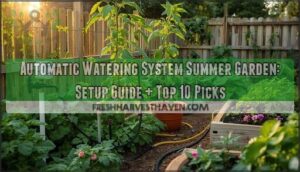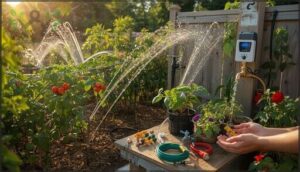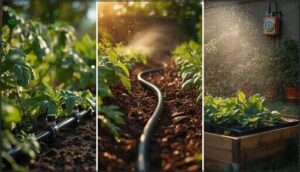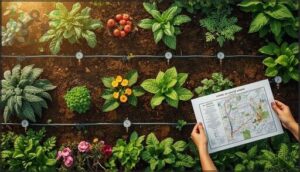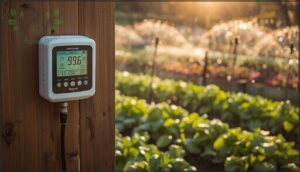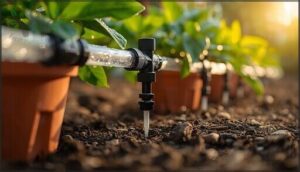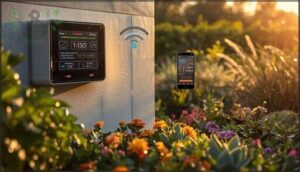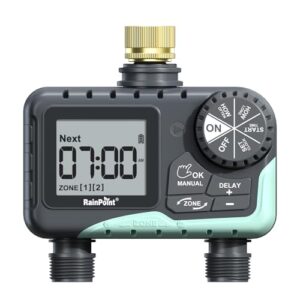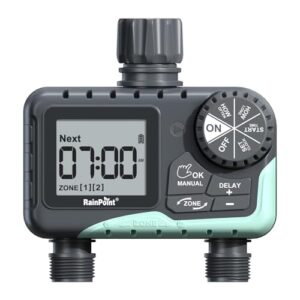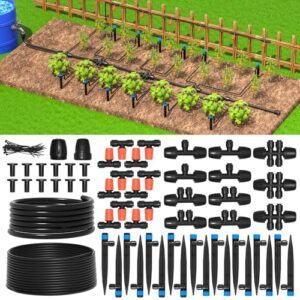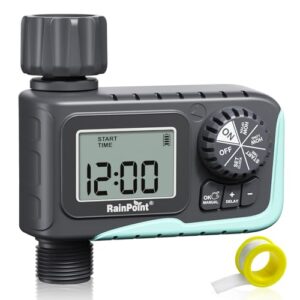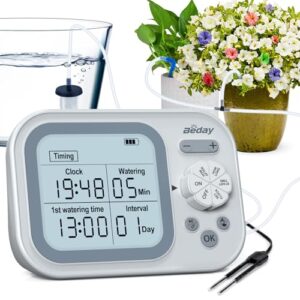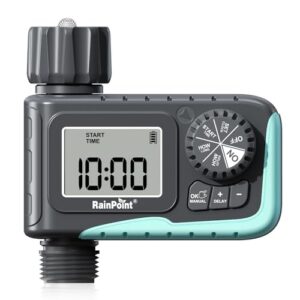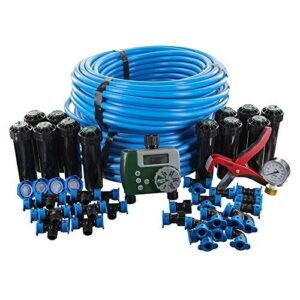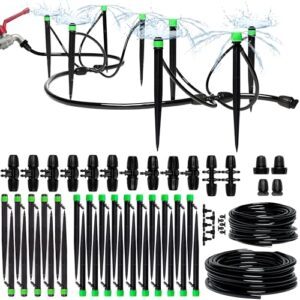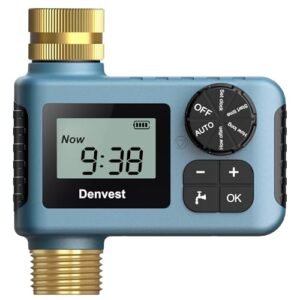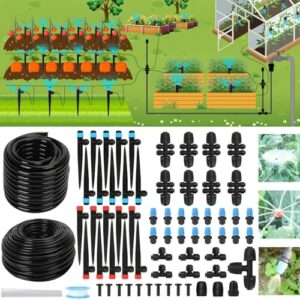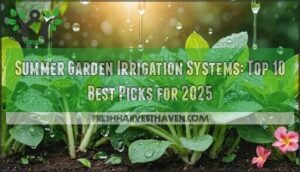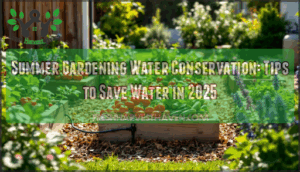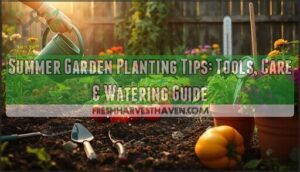This site is supported by our readers. We may earn a commission, at no cost to you, if you purchase through links.
By July, most summer gardens look more parched than a forgotten houseplant in a college dorm window. The midday sun cooks the soil, and watering by hand becomes a sweaty test of patience.
But automation changes the game—modern automatic watering systems aren’t just hoses on timers, they’re precision tools for thriving plants. Set up right, these systems keep every root at the perfect moisture sweet spot, sparing you from daily hose duty and giving your summer garden a fighting chance, even in the fiercest heat.
Here’s how to turn your patch of green into a self-sufficient oasis.
Table Of Contents
- Key Takeaways
- Benefits of Automatic Watering for Summer Gardens
- Choosing The Right Watering System
- Types of Automatic Watering Systems Explained
- Step-by-Step Installation Guide
- Top 10 Automatic Watering Systems for Summer Gardens
- 1. Rainpoint Dual Zone Water Timer
- 2. RAINPOINT Two Zone Water Timer
- 3. MIXC Micro Drip Irrigation Kit
- 4. RAINPOINT Sprinkler Timer Outdoor Watering Irrigation
- 5. Automatic Plant Waterer Drip Irrigation Kit
- 6. RAINPOINT Programmable Garden Hose Water Timer
- 7. Orbit 2-Zone Sprinkler System Kit
- 8. CARPATHEN Adjustable Drip Irrigation System Kit
- 9. Denvest Hose Water Timer with Brass
- 10. Drip Irrigation Kit Quick Connect System
- Frequently Asked Questions (FAQs)
- Conclusion
Key Takeaways
- Automatic watering systems keep your summer garden consistently hydrated, saving you time and rescuing plants from heat stress.
- Smart controllers and soil moisture sensors prevent overwatering and underwatering, optimizing water use while protecting plant health.
- System choice depends on your garden’s size, plant types, and preferences, with options ranging from simple timers to advanced drip kits and smart integrations.
- Durable, weather-resistant materials and the right power source make your setup reliable all season, while programmable features let you customize watering for each zone.
Benefits of Automatic Watering for Summer Gardens
Summer heat can turn your garden into a battleground between wilting plants and your packed schedule. An automatic watering system takes the guesswork out of irrigation while keeping your plants thriving through the season’s toughest conditions.
Automatic watering systems let your garden flourish through summer heat, giving you healthy plants without the hassle or guesswork
Let’s look at the key advantages these systems bring to your summer garden.
Consistent Moisture During Hot Weather
When summer heat stress hits hard, consistent hydration becomes your garden’s lifeline. Automated system yield improvements of up to 32% prove that preventing plant stress isn’t just about watering—it’s about moisture control precision.
To maintain prime plant health, consider that automatic watering systems guarantee consistent hydration. Soil moisture sensors paired with organic mulching benefits help you avoid drought stress and soil compaction issues, ensuring your plants thrive even when temperatures soar. Your watering schedule works while you don’t.
Time and Water Conservation Advantages
Beyond keeping plants hydrated, automation lets you minimize manual effort while cutting costs substantially. Smart controllers can slash outdoor water use by 20% to 50%, saving around 7,600 gallons annually—that’s serious money off your water bills.
Smart irrigation controllers use real-time data to improve watering schedules. Drip irrigation delivers water efficiency up to 80% better than traditional methods, making these eco-friendly solutions win on both time and conservation fronts.
Preventing Overwatering and Underwatering
You can’t eyeball soil moisture, which is why automatic systems with soil moisture sensors prevent the guesswork that leads to root rot risks or wilted plants. Smart controller features adjust watering frequency based on real-time data, keeping water levels precisely where your plants need them.
This irrigation scheduling delivers water-saving potential up to 88% while protecting plant health—no more drowning tomatoes or parched petunias.
Healthier Plants and Improved Growth
When your watering schedule hits that sweet spot, you’ll see the payoff in plant health—nutrient uptake jumps by 10-30%, stress reduction becomes visible in vibrant foliage, and root development deepens dramatically. Efficient watering strengthens disease resistance while boosting crop yield up to 35% in some cases.
- Enhanced nutrient absorption fuels faster growth and higher productivity
- Reduced stress symptoms mean fewer wilted leaves and stronger stems
- Deeper root systems create drought-resilient, well-anchored plants
Choosing The Right Watering System
Picking the right automatic watering system isn’t about grabbing the fanciest option—it’s about matching the setup to your garden’s specific needs and your lifestyle. You’ll want to think about everything from how much ground you’re covering to whether you’d rather swap batteries or let the sun do the work.
Let’s walk through the key factors that’ll help you choose a system you won’t regret come July.
Assessing Garden Size and Plant Types
Think of your garden as a living puzzle where every piece demands a different approach. Start with garden area measurement—multiplying length by width gives you the square footage needed for system design.
Then consider plant grouping strategy: cluster vegetable gardens, garden beds, and container plants by their water-use classification. Root depth consideration and soil type impact determine emitter placement, while your garden layout guides zone divisions for efficient coverage.
Customizable Scheduling and Zone Control
When you fine-tune watering schedules and zone configuration through programmable timers, you’re basically giving each plant exactly what it needs—nothing more, nothing less. Smart controllers with soil sensors can slash outdoor water use by 20% to 50%, automatically adjusting to moisture levels and weather patterns.
Customizable schedules let you assign independent zones for sun-loving perennials versus shade dwellers, promoting healthier growth while advancing water conservation goals.
Weather-Resistant and Durable Materials
Summer heat and relentless sunshine test every component in your garden. UV degradation attacks plastic tubing, while thermal performance determines whether hoses soften or crack at 80°C. You’ll want UV-resistant hoses with stabilizers—they last four times longer than untreated materials.
Brass fittings generally endure 40-70 years with excellent corrosion resistance, making weather-resistant designs essential for material lifespan. Heat effects matter more than you’d think.
Power Source Options (Battery, Solar, Electric)
Your power source shapes everything from system costs to environmental impact. Battery-powered systems offer flexibility and easy installation, though you’ll replace batteries annually. Solar panels deliver eco-friendly energy efficiency but face solar limitations in shaded gardens. Electric reliability wins for large-scale setups with consistent power, yet installation demands professional wiring.
Weigh battery lifespan against your garden’s sunlight exposure and grid access—there’s no universal answer.
Smart Features and Home Integration
Modern smart features transform watering from a chore into a conversation with your garden. Voice control through Alexa or Google Assistant lets you adjust schedules without touching a dial, while mobile apps deliver real-time alerts about moisture levels or system hiccups.
- AI integration analyzes weather patterns to slash water use by up to 50%
- Sensor optimization prevents overwatering by monitoring soil conditions continuously
- Data reporting tracks your conservation wins with detailed usage analytics
Smart home integration turns a programmable timer into an intelligent partner for your watering schedule.
Types of Automatic Watering Systems Explained
Not all automatic watering systems work the same way, and what suits a sprawling vegetable garden won’t necessarily fit your container tomatoes on the patio. You’ve got options ranging from simple hose-end timers to intricate drip networks that deliver water right where roots need it most.
Let’s break down the main types so you can match the right system to your garden’s specific needs.
Drip Irrigation Kits and Components
A quality drip irrigation kit starts with polyethylene mainline tubing—usually 1/2 inch—that carries water to adjustable drippers releasing 0.5 to 2 GPH. You’ll need pressure compensation emitters to maintain consistent flow across varying terrain, plus mesh filters requiring monthly cleaning to prevent clogs.
Essential drip irrigation system components include durable plastic fittings connecting everything together.
Installation costs run $0.50 to $5 per square foot, making drip irrigation surprisingly affordable for most gardens.
Soaker Hoses Vs. Sprinkler Systems
Soaker hoses deliver water directly to soil, cutting usage by 70% compared to sprinklers that spray overhead and waste moisture through evaporation. You’ll spend less on installation costs—soakers need simple hookup versus complex sprinkler heads and zoning—but sprinklers cover lawns better.
Here’s the trade-off: soakers prevent plant diseases by keeping foliage dry, while sprinklers risk increasing bacterial problems by 170% through wet leaves.
Terracotta Spikes and Olla Watering Methods
If soaker hoses kept leaves dry, terracotta watering spikes and olla watering systems go one better for sustainability and watering efficiency. These timeless self-watering systems drip just enough moisture right to the roots, boosting plant health and deep root growth.
Ollas lose far less water to evaporation, so you’ll refill less often—practical usage meets eco-friendly peace of mind for every garden.
Self-Watering Stakes for Containers
Once you’ve enjoyed the charm of terracotta watering spikes, you’ll love the no-hassle world of self-watering stakes for container plants. Here’s why folks keep reaching for these:
- Spike water efficiency cuts watering by 70%—give your wrists a break.
- Healthier roots spark lively, lush growth.
- Quick setup—just insert and refill. Garden liberation at its finest.
Smart and Programmable Controllers
Ready to take a break from daily guesswork? Smart controllers and programmable timers know exactly what your plants need, thanks to weather integration and moisture sensors.
These feature-rich marvels offer remote access and customizable schedules, letting you tweak watering schedules from your phone—rain delay, zone control, and smart features save water and spark real garden confidence.
No more watering roulette, just peace of mind.
Step-by-Step Installation Guide
Getting your garden’s automatic watering system up and running can be straightforward with a little planning. Here’s how to get started, step by step. Each part builds on the last, so you’ll feel confident as you go.
Planning Layout and Watering Zones
Think of garden irrigation like planning a road trip: you wouldn’t hit the highway without a map. Effective watering zones start with soil assessment and hydrozoning benefits—grouping plants by thirst and root depth. Factoring in pressure requirements and plant grouping under water restrictions gives you customizable schedules and boosts drip irrigation efficiency.
Here’s how to start:
- Map sun, soil, and plant needs.
- Group similar plants together.
- Assign pressure-appropriate equipment.
Setting Up Timers and Controllers
A good timer is like a conductor for your garden—timing each performance to excellence. Programmable timers let you fine-tune watering schedules, with zone programming for specific coverage. Schedule optimization features, backup memory for power outages, and energy consumption stats are now standard. With market trends leaning smart, modern controllers offer customizable schedules and easy watering schedule programming.
| Feature | Benefit | Tip |
|---|---|---|
| Schedule Optimization | Reduces water waste | Match to plant needs |
| Zone Programming | Customizes irrigation | Separate turf and beds |
| Power Outage Memory | Maintains schedules | Check controller battery |
| Energy Consumption | Lowers utility costs | Adjust for daily use |
Connecting Hoses, Emitters, and Spikes
Between each plant and your water source runs a network of hoses and connectors, all hinging on solid hose connection integrity. Fit adjustable drippers and drip emitters with barbed distribution tube fittings at every plant, then secure with end caps.
After installing watering spikes for containers, always flush your drip irrigation system—catch any leaks early to safeguard flow rates and efficient coverage.
Programming Custom Watering Schedules
What sets a thriving summer garden apart? Effortlessly programmed watering schedules. Nailing your Zone Configuration makes all the difference—assign zones by plant need, then:
- Adjust Watering Frequency for each section.
- Leverage Weather Integration to cut back on water waste.
- Use a programmable timer for customizable irrigation schedules.
- Embrace Manual Override and Remote Control for on-the-fly routine tweaks.
Top 10 Automatic Watering Systems for Summer Gardens
Summer brings its own challenges for garden watering, but there are plenty of smart solutions that make the job easier. If you’re wondering which system will work best for your space, you’re in the right spot.
Here are ten top contenders to keep your summer garden thriving.
1. Rainpoint Dual Zone Water Timer
When scorching summer sun puts your soil to the test, the RAINPOINT Dual Zone Water Timer delivers steadfast hydration without fuss. With true Dual Zone Benefits, you get Programming Flexibility—each zone can run unique watering schedules, perfect for specific garden needs. The programmable timer boasts a standout rain delay feature and straightforward Installation Ease—just pop in batteries and attach.
Battery Life runs strong for a whole season, giving peace of mind. For gardeners craving reliable automation, this dualzone design is a real innovation.
Best For: Gardeners who want easy, customizable irrigation for two different zones without complicated setup or smart tech.
- Lets you set separate, flexible watering schedules for each zone.
- Simple tool-free installation and user-friendly programming with a clear LCD screen.
- Long battery life with automatic shut-off and rain delay to prevent overwatering.
- No Wi-Fi, app, or voice control on the base model.
- Hose connections may need extra sealing to avoid leaks.
- Battery replacement is needed every season, and lifespan can vary by usage.
2. RAINPOINT Two Zone Water Timer
Want real control over your garden’s thirst? The RAINPOINT Two Zone Water Timer puts you in the driver’s seat with dual-zone control—tailor watering schedules for each area, freeing you from guesswork.
Smart features like rain delay and real-time flow monitoring mean you never waste a drop, supporting true water conservation.
Built for rugged summers, its durable build quality and battery performance keep things steady, while the easy-to-use programmable timer makes scheduling easy.
This dualzone design is a practical upgrade for anyone serious about thriving plants.
Best For: Gardeners and homeowners who want effortless, hands-on control over two separate garden zones without fussing with complicated tech.
- Customizable schedules for two zones save time and keep different plants healthy.
- Smart rain delay and flow monitoring maximize water savings and prevent overwatering.
- Robust, weatherproof build with easy-to-read display is simple for anyone to set up.
- Batteries need changing periodically, so maintenance is required.
- No Wi-Fi or app options for remote control or automatic weather adjustment.
- Needs careful installation to avoid leaks, and might not last through many seasons.
3. MIXC Micro Drip Irrigation Kit
Moving from high-tech timers to hands-on flexibility, the MIXC Micro Drip Irrigation Kit shines when you want precise coverage and true water savings. This DIY-friendly drip kit lets you string together up to 16 lines, and with adjustable nozzles, you can customize watering for every thirsty garden bed or potted display.
The durable tubing and connectors offer material durability, even in harsh weather. You’ll enjoy the drip irrigation system advantages—direct-to-root moisture and less waste—while keeping everyday maintenance simple and stress-free.
Best For: Gardeners and homeowners looking for an easy, customizable way to water small to medium gardens without wasting water.
- Saves up to 70% more water compared to hand-watering.
- Easy to install and fits most outdoor taps without extra tools.
- Adjustable nozzles allow tailored watering for different plant needs.
- Main hose may be too short for larger or spread-out spaces.
- Barbed fittings can be tricky and need a bit of patience to secure.
- Instructions are only in German, which can make setup harder for some.
4. RAINPOINT Sprinkler Timer Outdoor Watering Irrigation
If your garden calls for flexible Timer Programming and resilience in the summer heat, the RAINPOINT Sprinkler Timer is a true workhorse. Its Dual Zones let you fine-tune each area’s watering schedule—perfect when your tomatoes and perennials refuse to play by the same rules.
Rain Delay and manual overrides help you conserve water without sacrificing results. Rugged valve durability, a generously sized display, and solid Battery Life combine for worry-free outdoor watering.
This programmable timer keeps your garden irrigation on track, rain or shine.
Best For: Gardeners who want a customizable, set-and-forget watering system that works for two separate zones, rain or shine.
- Easy to use with a large, clear LCD screen that makes setup simple even in bright sunlight.
- Dual-zone programming allows flexible schedules for different garden areas or plant types.
- Durable, weatherproof build with a reliable leak-proof valve and helpful rain delay feature for efficient, eco-friendly watering.
- Buttons and interface may feel small or tricky to use for some, especially during first setup.
- Limited to two watering zones, so it won’t suit very large or complex gardens.
- Battery life depends on use and weather, and the timer needs regular checks to avoid shutdown or stuck valves.
5. Automatic Plant Waterer Drip Irrigation Kit
Here’s where a drip irrigation kit truly shines for summer gardening. The Automatic Plant Waterer brings together adjustable emitter placement, smart timer controls, and flexible flow rates—giving you the reins over your watering schedule.
Whether you’ve packed pots by the patio or cultivated a leafy jungle indoors, this system expands easily, letting you customize for every plant’s thirst. Steady water pressure equals consistent hydration, so you’ll spend less time troubleshooting and more enjoying your garden flourishing under a worry-free automatic watering system.
Best For: Busy plant lovers or frequent travelers who want an easy, hands-off way to keep up to 15 indoor plants consistently watered.
- Offers automatic, scheduled watering that adjusts based on real humidity—no constant monitoring needed.
- Saves water and time with efficient drip irrigation, reducing both waste and guesswork.
- Simple setup with handy accessories and an easy-to-use, rechargeable design.
- Water supply capacity may limit how long it can run between refills, especially for larger collections.
- Humidity sensor isn’t adjustable and might not be reliable in all environments.
- Not ideal for plants that each need vastly different watering routines.
6. RAINPOINT Programmable Garden Hose Water Timer
Never underestimate the power of timing—especially with the RAINPOINT Programmable Garden Hose Water Timer. Reliable timer programming lets you set up to 20 custom watering schedules for every nook of your landscape. With rain delay at your fingertips, you won’t waste a drop during a summer downpour.
Battery life runs season after season, and you’ll appreciate how user reviews praise its simplicity and water savings. Secure this to any hose faucet, set your preferences, and let automatic watering systems do the mindful work.
Best For: Anyone who wants to easily automate watering for gardens, lawns, or multiple outdoor zones without daily fuss.
- Lets you set up to 20 different watering schedules with flexible durations and frequencies.
- Built-in rain delay and weather resistance save water and protect against the elements.
- Large LCD screen and user-friendly setup make programming quick—even for beginners.
- Occasional reports of timers stopping unexpectedly or not running as programmed.
- Battery life varies and requires seasonal checks or replacement.
- Manual and support may not be available in all languages, which can cause confusion.
7. Orbit 2-Zone Sprinkler System Kit
Versatility matters when you want lush growth without the hassle, and that’s where the Orbit 50021 2Zone AllinOne Automatic Watering System shines. With Blu-Lock tubing for lightning-fast connections and dependable zone customization, you can fine-tune water coverage across sprawling lawns and garden beds.
Timer programming is straightforward—even if you’re new to outdoor watering—and installation ease means you won’t spend hours wrangling pipes. For automatic watering systems that balance power, efficiency, and a truly programmable timer, this kit holds its own.
Best For: Homeowners who want a quick-to-install, automatic sprinkler system for large lawns or garden spaces without the need for professional help.
- Fast and easy installation with Blu-Lock tubing and comprehensive instructions.
- Programmable digital timer for fully customizable watering schedules and rain delay.
- Covers up to 2,500 square feet with adjustable sprinkler heads for tailored watering.
- Limited to 4-6 sprinkler heads per zone, potentially requiring extra kits for larger coverage.
- May need additional fittings for complex yard layouts or larger designs.
- Some users report occasional leaks or weak connections, especially if setup guidelines aren’t followed.
8. CARPATHEN Adjustable Drip Irrigation System Kit
One standout for hands-off summer watering is the CARPATHEN Drip Irrigation System Kit. With adjustable emitters and a complete set of kit components, you get precise control over each plant’s thirst—whether you need a trickle or a flood.
Installation time clocks in at about 30 minutes, so you’ll be back to relaxing before the sun climbs. You tap into water savings of up to 50%, and high user satisfaction is the norm, thanks to sturdy construction and adjustable nozzles.
Best For: Busy gardeners, homeowners with diverse plant beds, or anyone wanting low-effort, water-saving irrigation that adapts to every plant.
- Easy 30-minute installation with adjustable emitters for precise, waste-free watering.
- Durable, UV-resistant tubing and leak-proof connectors hold up above or below ground.
- Cuts water use by up to 50% and supports automated schedules with timers.
- May need extra tubing or fittings for large or unusually shaped beds.
- Some users have struggled with unclear instructions and breakable sprinkler inserts.
- Replacing or expanding with individual parts can be tricky due to limited availability.
9. Denvest Hose Water Timer with Brass
Precision matters when summer heat threatens your garden. The Denvest Hose Water Timer with Brass stands out for its durable brass connector, IP55 waterproof rating, and easy-to-read programmable timer.
With user feedback highlighting its reliable six-month battery life and large LCD display, setting up a custom watering schedule feels refreshingly simple.
Smart connectivity lets you manage watering from your phone or voice assistant, so you can keep control even while away. That’s practicality—and resilience—woven into every detail of this automatic watering system.
Best For: Busy gardeners, frequent travelers, or anyone looking for an easy, reliable way to manage outdoor watering with the flexibility of smart controls.
- Simple to use, with customizable schedules and remote control via app or voice.
- Brass connector and IP55 waterproofing make it durable and long-lasting.
- Versatile for different settings—gardens, lawns, pools, and more.
- Rain delay is manual, not automatically triggered by weather.
- App notifications can be excessive and may get annoying.
- Some reports of cracks or malfunctions after a few months of use.
10. Drip Irrigation Kit Quick Connect System
Looking to turn “hose wrangling” into a relic of the past? The Drip Irrigation Kit Quick Connect System is the height of easy installation—just click, connect, and go.
Its weatherproof material quality stands up to merciless sun, while water efficiency means you waste less, even at peak summer. You’ll notice water conservation right away; specific emitters help every plant thrive.
This drip irrigation kit balances upfront cost with long-term savings, driving strong user satisfaction among gardeners who value reliable, automatic watering systems.
Best For: Home gardeners and DIY enthusiasts looking for a simple, reliable way to water plants automatically while saving water and time.
- Quick connect system makes setup and seasonal maintenance fast and stress-free.
- Adjustable emitters and modular parts let you tailor watering for different plants, boosting garden health.
- Conserves water and lowers bills, with durable materials designed to last through harsh weather.
- Not designed for commercial-scale use; best for household gardens and small setups.
- May need extra tubing or parts for larger or custom garden layouts.
- Some emitters can spray unevenly when pressure drops or set to low flow.
Frequently Asked Questions (FAQs)
How do I maintain my automatic watering system?
Keeping your watering system healthy means scheduling quarterly filter cleaning, tightening leaky fittings, updating programming, and checking for debris or blockages.
Don’t skip winterization—protect those durable components, or weather resistance won’t save you from mid-winter freeze-ups!
What are common troubleshooting tips for water flow issues?
Spot flow issues fast: use a pressure gauge for water pressure requirements, flush your drip irrigation system for emitter clog removal, inspect tubing size for proper water flow, check for leaks, and confirm valves aren’t malfunctioning.
How does weather affect system performance in summer?
Weather conditions shape system performance—summer heat stress increases evaporation, triggering more frequent watering.
Smart Weather Adaptations, like Rainfall Sensing and wind-prompted adjustments, respond to shifts in Humidity Influence and Temperature Impacts, ensuring efficient water management and reducing waste.
Is automatic watering safe for all soil types?
You might think automatic watering fits every garden, but soil water retention swings the story. Clay’s prone to overwatering risks, while sandy types crave frequent watering.
Sensor integration and specific irrigation help soil-specific systems manage water levels and frequency brilliantly.
How do I winterize my automatic watering setup?
Start winterizing your watering system by draining all lines—manual, automatic, or blow-out drainage methods work best.
Insulate exposed valves and controllers, protect antisiphon devices, and weigh DIY cost analysis versus professional service for lasting weather-resistant durability.
Conclusion
Picture your summer garden as a ship at sea—roots thirsting for just the right tide. An automatic watering system is your skilled crew, keeping every plant in balance as the sun scorches overhead.
With thoughtful setup and the right tools, you trade frantic rescue missions for smooth sailing. Suddenly, you’re not the harried captain, but the wise navigator—confident, resourceful, and assured your oasis will flourish through even the most unrelenting waves.
- https://irrigationtech.com/types-of-automatic-irrigation-systems
- https://gardeninminutes.com/collections/garden-grid-watering-systems
- https://ladwp.cafriendlylandscaping.com/Garden-Resources/IrrigationType.php
- https://rainbird.com/homeowners/blog/how-water-smart-irrigation-systems-help-save-the-planet
- https://www.dripworks.com/blogdrip-irrigation-vs-traditional-watering-methods-a-comparative-study

